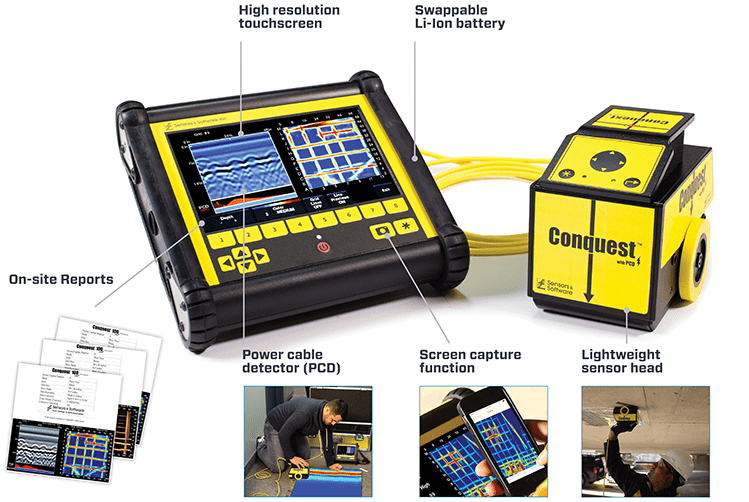Optimizing Performance and Minimizing Threats: The Function of Concrete Scanning in Building
In the world of building, where precision and safety and security are critical, the usage of concrete scanning innovation has actually become a vital device for task supervisors and engineers alike. By using innovative scanning methods, construction groups can navigate complicated environments with heightened effectiveness while minimizing possible dangers that can endanger both spending plans and timelines. The detailed dance in between taking full advantage of efficiency and decreasing risks in building and construction rest on the ability to peer beneath the surface area, disclosing a world of surprise barriers and chances. The duty of concrete scanning in this delicate balance is not just encouraging but transformative, offering a glimpse into a future where pricey mistakes are preempted, safety and security is focused on, and top quality is non-negotiable.
Significance of Concrete Scanning
Concrete scanning plays a critical role in guaranteeing the structural integrity and safety of building tasks by properly finding ingrained things and possible dangers within concrete structures. By using numerous scanning innovations such as ground-penetrating radar (GPR) and electro-magnetic induction, construction groups can determine rebar, post-tension cables, channels, and various other surprise challenges before exploration, cutting, or coring into concrete. This aggressive approach aids prevent costly damages, injuries, and project hold-ups that might develop from accidentally striking these items during construction tasks.
Additionally, concrete scanning aids in compliance with safety policies and quality criteria by giving precise information about the problem of concrete structures. It permits job managers and engineers to make educated decisions regarding architectural alterations, repair work, or supports based upon reliable information obtained with scanning processes. Furthermore, the precise mapping of ingrained things makes sure the efficient implementation of construction strategies, reducing the risk of mistakes and making sure the long life and sturdiness of the developed setting. Inevitably, purchasing concrete scanning services contributes to the general success and safety and security of building projects.

Advanced Modern Technology in Building
Provided the raising demand for precision and performance in construction methods, the integration of advanced modern technology has come to be crucial in boosting project results and guaranteeing ideal safety and security actions. BIM permits for much better cooperation amongst stakeholders, improved visualization of the project, and enhanced decision-making throughout the construction procedure. The implementation of Increased Truth (AR) and Digital Truth (VR) innovations in construction design and preparation phases makes it possible for stakeholders to picture the final item, identify prospective issues, and make needed adjustments prior to building and construction starts.

Benefits of Things Mapping
The utilization of object mapping technology in building and construction jobs uses a plethora of benefits that boost job preparation and execution. One of the crucial advantages of things mapping is its capacity to provide detailed and exact information regarding the area of underground utilities, architectural components, and various other things within the construction site. This details is crucial for making sure that excavation and boring tasks are executed securely and successfully, decreasing the threat of damages to existing infrastructure.
Additionally, object mapping modern technology makes it possible for construction teams to create accurate 3D designs of the website, permitting better visualization of the project and enhanced control among different professions - RainierGPR Concrete Scanning. This enhanced spatial understanding assists to recognize potential clashes and conflicts early in the drawing board, lowering the demand for pricey rework and delays during building
Furthermore, item mapping can likewise improve the documents process by supplying electronic records of the site his explanation previously, throughout, and after construction. These documents work as important referrals for future maintenance and restoration projects, eventually boosting the long-lasting efficiency and sustainability of the built environment.
Protecting Against Costly Blunders
Object mapping innovation's role in building and construction prolongs beyond boosting job preparation and implementation to include a critical facet: stopping expensive mistakes. By using innovative concrete scanning strategies, construction groups can recognize potential threats such as rebar blockage, post-tension cable televisions, or voids within concrete structures. Overall, the aggressive usage of concrete scanning modern technologies in building and construction projects considerably lessens the danger of errors and eventually contributes to cost financial savings and task performance.
Ensuring Safety And Security and Top Quality
To promote the highest criteria of safety and high quality in building and construction jobs, the implementation of concrete scanning innovation plays a crucial role. By utilizing advanced scanning methods such as ground-penetrating radar (GPR) and electro-magnetic induction, building and construction teams can discover possible hazards concealed within concrete frameworks before beginning any kind of work. This aggressive strategy not just lessens the risk of crashes on the construction website yet likewise makes sure the architectural integrity of the building.
Concrete scanning also assists in confirming the positioning of rebar, avenues, and post-tension wires, assuring that these components are correctly positioned according to the layout specs. This accuracy in finding crucial parts assists prevent errors during the building process, eventually resulting in a better finished product. Furthermore, by recognizing any anomalies or disparities within the concrete weblink early, needed changes can be made quickly, lowering the possibility of rework and pricey hold-ups.
In significance, concrete scanning innovation acts as a beneficial tool in guarding both the security of building and construction employees and the total high quality of the constructed atmosphere. Its ability to identify prospective risks and make sure adherence to style standards makes it an essential property in contemporary construction methods.

Conclusion
In final thought, concrete scanning plays a crucial role in making the most of effectiveness and decreasing threats in building and construction tasks. By making use of sophisticated modern technology for things mapping, possible pricey mistakes can be prevented, making sure safety and security and top quality of the last structure. It is vital for building and construction companies to prioritize using concrete scanning to improve productivity, mitigate threats, and provide premium results in their projects.
Concrete scanning plays a crucial duty in making sure the structural integrity and safety and security of building and construction jobs by accurately detecting ingrained things and prospective dangers within concrete frameworks. The execution of Increased Fact (AR) and Online Fact (VIRTUAL REALITY) modern technologies in construction style and planning phases enables stakeholders to imagine the last item, identify prospective issues, and make necessary changes prior to construction look at these guys starts. By employing sophisticated concrete scanning techniques, building teams can determine prospective threats such as rebar congestion, post-tension wires, or voids within concrete frameworks. Overall, the positive usage of concrete scanning innovations in building and construction jobs considerably decreases the risk of mistakes and inevitably contributes to set you back savings and task performance.
To promote the highest possible standards of safety and quality in building and construction jobs, the execution of concrete scanning technology plays a critical role.